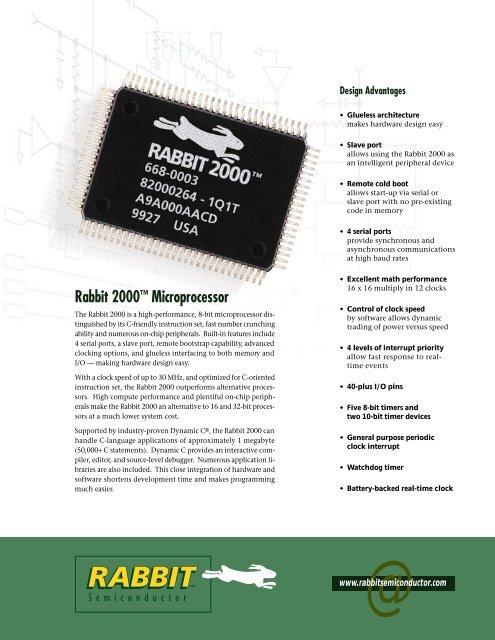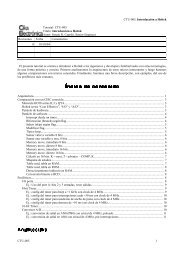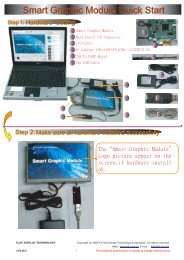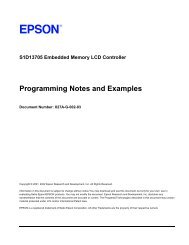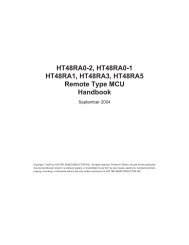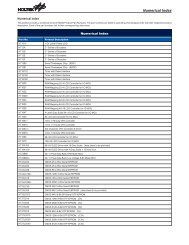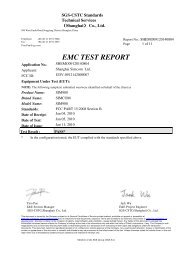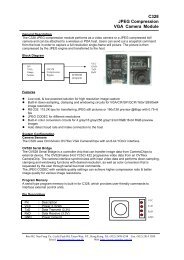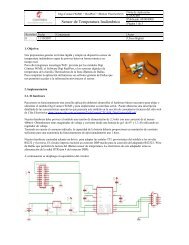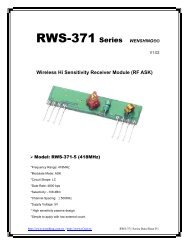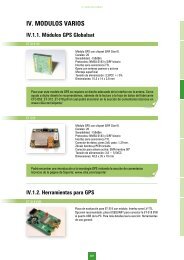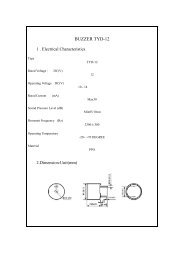Rabbit 2000™ Microprocessor
Rabbit 2000™ Microprocessor
Rabbit 2000™ Microprocessor
You also want an ePaper? Increase the reach of your titles
YUMPU automatically turns print PDFs into web optimized ePapers that Google loves.
Design Advantages<br />
• Glueless architecture<br />
makes hardware design easy<br />
• Slave port<br />
allows using the <strong>Rabbit</strong> 2000 as<br />
an intelligent peripheral device<br />
• Remote cold boot<br />
allows start-up via serial or<br />
slave port with no pre-existing<br />
code in memory<br />
• 4 serial ports<br />
provide synchronous and<br />
asynchronous communications<br />
at high baud rates<br />
<strong>Rabbit</strong> 2000 <strong>Microprocessor</strong><br />
The <strong>Rabbit</strong> 2000 is a high-performance, 8-bit microprocessor distinguished<br />
by its C-friendly instruction set, fast number crunching<br />
ability and numerous on-chip peripherals. Built-in features include<br />
4 serial ports, a slave port, remote bootstrap capability, advanced<br />
clocking options, and glueless interfacing to both memory and<br />
I/O — making hardware design easy.<br />
With a clock speed of up to 30 MHz, and optimized for C-oriented<br />
instruction set, the <strong>Rabbit</strong> 2000 outperforms alternative processors.<br />
High compute performance and plentiful on-chip peripherals<br />
make the <strong>Rabbit</strong> 2000 an alternative to 16 and 32-bit processors<br />
at a much lower system cost.<br />
Supported by industry-proven Dynamic C®, the <strong>Rabbit</strong> 2000 can<br />
handle C-language applications of approximately 1 megabyte<br />
(50,000+ C statements). Dynamic C provides an interactive compiler,<br />
editor, and source-level debugger. Numerous application libraries<br />
are also included. This close integration of hardware and<br />
software shortens development time and makes programming<br />
much easier.<br />
• Excellent math performance<br />
16 x 16 multiply in 12 clocks<br />
• Control of clock speed<br />
by software allows dynamic<br />
trading of power versus speed<br />
• 4 levels of interrupt priority<br />
allow fast response to realtime<br />
events<br />
• 40-plus I/O pins<br />
• Five 8-bit timers and<br />
two 10-bit timer devices<br />
• General purpose periodic<br />
clock interrupt<br />
• Watchdog timer<br />
• Battery-backed real-time clock<br />
@<br />
www.rabbitsemiconductor.com
The Instruction Set<br />
The <strong>Rabbit</strong> 2000 features an updated<br />
Z180 style architecture improved<br />
for higher performance.<br />
A number of obsolete or redundant<br />
Z180 instructions have been<br />
dropped to allow efficient 1-byte<br />
operation-codes for new instructions.<br />
Existing Z180 assembly<br />
language can be ported to the<br />
<strong>Rabbit</strong> 2000 with minimal<br />
change.<br />
New C-friendly instructions are<br />
included for fetching and storing<br />
16-bit words located at a computed<br />
memory address or on the<br />
stack. New instructions perform<br />
fetches, stores, calls, returns and<br />
jumps over a full megabyte of address<br />
space.<br />
The new instructions improve<br />
communication between Z180<br />
registers, effectively enlarging the<br />
register set. Other new instructions<br />
provide 16-bit logical and<br />
arithmetic operations. Software<br />
floating point routines for add,<br />
subtract, and multiply require less<br />
than 12 microseconds at maximum<br />
clock speed.<br />
Memory access instructions can<br />
be turned into I/O access instructions<br />
by using a prefix. As a consequence,<br />
I/O access is faster and<br />
more flexible.<br />
The new instructions are natural<br />
improvements to the Z180 instructions,<br />
making a comfortable<br />
environment for the experienced<br />
Z80/Z180 assembly language programmer.<br />
Hardware Architecture<br />
Interrupt Structure<br />
Four levels of interrupt priority allow fast response to real-time<br />
events. Complete interrupt routines can execute in less than 4 microseconds.<br />
16-bit load and store I/O instructions improve I/O data<br />
transfer speed. Data transfer rates in excess of 250,000 bytes per second<br />
can be obtained using interrupts.<br />
Memory Management/Glueless Design<br />
• Three built-in memory chip select lines<br />
• Two memory chip output enable lines<br />
• Two memory chip write enable lines<br />
• Up to six static memory chips (RAM, flash) connect directly to<br />
the <strong>Rabbit</strong> 2000 without glue logic<br />
• Glueless architecture makes memory design much easier<br />
• One megabyte normal code space accessible directly by call and<br />
jump instructions<br />
• More memory is easily supported<br />
Figure 2, Example<br />
Processor Core using<br />
a <strong>Rabbit</strong> 2000<br />
<strong>Microprocessor</strong><br />
Battery Backup Feature<br />
The <strong>Rabbit</strong> 2000 has a special support feature<br />
for battery-backed RAM. In typical<br />
processors, a battery switch-over circuit<br />
maintains at least 2 volts of power to<br />
RAM and pulls the chip select line up to<br />
the same voltage as the battery. This<br />
method has a propagation delay often as<br />
much as 20 nanoseconds.<br />
The <strong>Rabbit</strong>'s special battery backup feature<br />
allows chip select #1 to be always<br />
forced low under program control, thus<br />
avoiding clock slow down. A hardware<br />
memory write-protect feature protects<br />
battery-backed RAM and flash memory<br />
from inadvertent write operations.<br />
Figure 1, Block Diagram of <strong>Rabbit</strong> 2000<br />
2
On-Chip Peripherals<br />
Slave Interface<br />
The slave port allows the <strong>Rabbit</strong> 2000 to be treated as an intelligent<br />
peripheral device. The slave port has six I/O registers, three for each<br />
direction. Handshaking flags and mutual interrupt capability are supported.<br />
This feature is excellent for off-loading communications protocols<br />
or motion control functions.<br />
Clock Speed<br />
The <strong>Rabbit</strong> 2000 performs 1-byte<br />
reads (and most 1-byte operations)<br />
in two clock cycles, and 1-byte<br />
writes in three clock cycles. It requires<br />
55 nanosecond memory to<br />
operate at 30 MHz with no wait<br />
states. The <strong>Rabbit</strong> 2000 runs at 24<br />
MHz with 70 nanosecond flash<br />
memory and no wait states. The<br />
<strong>Rabbit</strong> 2000 is about 3 times faster<br />
than the Z180 for the same<br />
memory speed running C code.<br />
Time/Date Oscillator<br />
Figure 3, Slave Processor Data Paths<br />
Remote Bootstrap<br />
The <strong>Rabbit</strong> 2000 may be remotely booted by an external device via serial<br />
port or slave port with no pre-existing program. This allows complete reprogramming<br />
of soldered-in flash memory. Also allows RAM-only configurations<br />
with external boot and program initialization.<br />
I/O Interface and Ports<br />
There are 40-plus I/O pins grouped in five 8-bit ports. Eight external<br />
programmable I/O interface signals can be configured as I/O chip selects,<br />
I/O write strobes, I/O read strobes and I/O read/write strobes.<br />
Standard I/O read and I/O write enable signals are also available. I/O<br />
devices can be directly connected to the I/O interfaces, and often<br />
without glue logic.<br />
Four asynchronous serial ports are on-chip. Two of the ports also<br />
have synchronous communication capability. The asynchronous<br />
ports operate at speeds up to 1/32 of the clock frequency, while synchronous<br />
mode allows baud rates up to 1/8th of the clock frequency.<br />
Timer synchronized parallel I/O allow generation of pulses under software<br />
control, but precisely synchronized by hardware timers.<br />
Low Power Sleepy Mode<br />
A unique sleepy mode of operation is available on the <strong>Rabbit</strong> 2000.<br />
Normally, the main oscillator is implemented by directly connecting a<br />
crystal or ceramic resonator with a frequency in the range of 1.8 to 30<br />
MHz. The frequency can be doubled or divided by 8 internally to<br />
modulate power consumption and speed of execution. In sleepy<br />
mode, the main oscillator is turned off and the main clock is taken<br />
from the <strong>Rabbit</strong>'s 32.768 kHz oscillator. Roughly 3,000 instructions<br />
per second can be executed with a current consumption of around<br />
200 µA. The sleepy mode is far more flexible than sleep modes of<br />
other microprocessors because instruction execution and decision<br />
making capability are maintained. This feature is excellent for many<br />
battery-powered applications.<br />
The 32.678 kHz oscillator uses an<br />
external 32.768 kHz quartz crystal.<br />
The 32.768 kHz clock is used<br />
to drive a battery-backable internal<br />
48-bit counter or real-time<br />
clock.<br />
Timers<br />
The <strong>Rabbit</strong> 2000 has two sets of<br />
timers, as well as a general purpose<br />
clock interrupt. The periodic<br />
interrupt is driven by the 32.768<br />
kHz oscillator divided by 16, giving<br />
an interrupt every 488 microseconds<br />
if enabled.<br />
Timer A consists of five 8-bit<br />
reloadable down counters. The<br />
output of four of the timers is<br />
used to provide baud clocks for<br />
the serial ports. These timers can<br />
also cause interrupts and clock the<br />
timer synchronized parallel output<br />
ports.<br />
Timer B consists of a 10-bit free<br />
running counter and contains two<br />
10-bit match registers. The timer<br />
generates an output pulse whenever<br />
the counter reaches the<br />
match value. This output pulse<br />
can be programmed to generate<br />
an interrupt.<br />
Packaging<br />
100-pin rectangular PQFP<br />
Electrical And Environmental<br />
Operating Voltage: 2.5 to 5 volts<br />
Operating Temp: -40° C to 85° C<br />
Storage Temp: -55° C to 125° C<br />
3
<strong>Rabbit</strong> 2000 Software Development<br />
Software is developed using Dynamic C®, a C language development<br />
system. Dynamic C operates on a PC under Windows or Windows NT<br />
and includes:<br />
• Easy-to-use program editor<br />
• Fast C compiler that compiles, links, and downloads directly to<br />
your target in one step<br />
• Embedded assembler<br />
• Source-level debugger<br />
• Hundreds of functions in source-code libraries<br />
No In-Circuit Emulator Needed<br />
A simple smart cable connects the PC serial port to one of the <strong>Rabbit</strong><br />
2000 processor's serial ports while the processor is running in the target<br />
system. No in-circuit emulator is needed, simplifying development.<br />
Dynamic C libraries contain highly developed software for the <strong>Rabbit</strong><br />
2000 microprocessor. Developing software with Dynamic C is easy.<br />
Code can be written in C or Assembly, compiled and tested without<br />
leaving the Dynamic C development environment.<br />
Features of Dynamic C<br />
Dynamic C is specifically tailored<br />
for embedded systems. It is designed<br />
to compile the users program<br />
and applicable library routines<br />
and simultaneously download<br />
the compiled code to the target<br />
system.<br />
Compilation is quick allowing<br />
rapid correction of errors.<br />
Breakpoints, single stepping, observation<br />
of variables in a running<br />
program, complex watch expressions,<br />
and printf to the Dynamic<br />
C console are all supported to aid<br />
in debugging. Dynamic C also<br />
supports cooperative multitasking<br />
through language extensions.<br />
Assembly language code may be<br />
embedded in C code or be supplied<br />
as a stand alone function.<br />
Dynamic C includes device drivers<br />
for <strong>Rabbit</strong> 2000 on-chip peripheral<br />
devices. The floating point<br />
and math libraries supplied with<br />
Dynamic C are notable for exceptional<br />
speed of execution.<br />
STDIO Window<br />
Easily track the progress of a program using<br />
printf output on the standard<br />
I/O window.<br />
Register, Stack, and<br />
Assembly Windows<br />
Pop-up windows display the contents of<br />
the target system's registers and stack,<br />
together with equivalent assembly language.<br />
All three windows are updated<br />
with a snapshot of the most recent information<br />
every time the debugger comes to<br />
a stopping place. These windows provide<br />
valuable information when searching for<br />
a program error or when optimizing code.<br />
Watch Window<br />
Easily monitor and change program variables<br />
and evaluate C expressions at any<br />
time. You can execute function calls from<br />
the watch dialog.<br />
4
Clock (MHz) Voltage Current (mA) Power (mW)<br />
29.412 5.0 109 545<br />
14.7456 5.0 58 290<br />
14.7456 3.3 36 118<br />
3.6864 3.3 11 36<br />
1.8432 3.3 6 20<br />
Sleepy Mode 0.032 5.0 280µA 1400µW<br />
“ 0.032 3.3 113µA 372µW<br />
“ 0.032 2.7 72µA 194µW<br />
Note: The processor clock is<br />
derived from the main oscillator<br />
output and can also be driven<br />
by the 32.768 kHz<br />
oscillator — excellent for low<br />
power applications.<br />
Figure 4, Power Consumption (typical)<br />
Figure 5, Pinout of <strong>Rabbit</strong> 2000<br />
5
<strong>Rabbit</strong> 2000 Development Kit<br />
The <strong>Rabbit</strong> 2000 Development Kit includes everything you need to fully evaluate<br />
the capabilities of the <strong>Rabbit</strong> 2000 microprocessor.<br />
You'll be able to develop software specific to your application using the Dynamic C ®<br />
development system while putting the <strong>Rabbit</strong> 2000 through the paces.<br />
Included in the Development Kit is a single-board computer with memory, I/O and a<br />
<strong>Rabbit</strong> 2000. No need to spend time developing an evaluation board. The included<br />
PC serial interface cable allows you to perform real-time debugging.<br />
Start your evaluation and design immediately. Call for your Development Kit today!<br />
Ordering Information<br />
Item<br />
Description<br />
<strong>Rabbit</strong> 2000 25 MHz CPU<br />
<strong>Rabbit</strong> 2000 30 MHz CPU<br />
Development See text above<br />
Kit<br />
Online Information<br />
• Manuals<br />
• Ordering<br />
• Tech Notes<br />
Only $ 139<br />
Includes:<br />
Single-board computer<br />
with 25MHz<br />
<strong>Rabbit</strong> 2000 processor,<br />
32K SRAM and<br />
128K Flash; prototyping<br />
board with<br />
LEDs, switches,<br />
beeper and prototyping<br />
area; PC serial<br />
cable; power supply;<br />
Dynamic C ® development<br />
software and<br />
documentation on<br />
CD ROM. All Dynamic<br />
C ® libraries<br />
and the debugging<br />
BIOS are included.<br />
www.rabbitsemiconductor.com<br />
■<br />
Tel 530.757.8400 Fax 530.757.8402<br />
email: rabbit@rabbitsemiconductor.com<br />
2932 Spafford Street Davis, CA 95616


